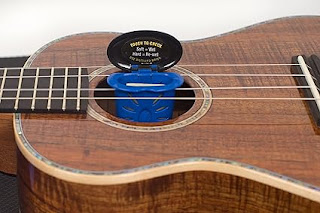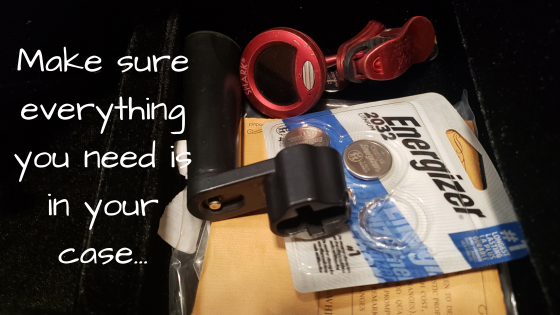You will Learn More and Play More with Play Ukulele NOW.
Find out for yourself why teachers and students have depended on Play Ukulele NOW Methods and Songbooks since 2009
Find out for yourself why teachers and students have depended on Play Ukulele NOW Methods and Songbooks since 2009
DISCLOSURE: THIS POST MAY CONTAIN AFFILIATE LINKS, MEANING I GET A COMMISSION IF YOU DECIDE TO MAKE A PURCHASE THROUGH MY LINKS, AT NO COST TO YOU. PLEASE READ MY DISCLOSURE FOR MORE INFO.
Care and feeding?
What do ukuleles eat?
Strings of course... So that's where we'll start - and along with string changes comes fretboard care.
Changing the strings & Fretboard and fret care
You should change the strings every 6 months or so and when you change the strings you should always clean the fretboard and polish the frets - it's easy to do.
A string winder makes string changes quick and easy - I like this one because of the ergonomic grip and the ability to store things inside it...
GET YOURS: JIM DUNLOP 114SI Deluxe Guitar Stringwinder
String brands
If you haven't already - you should experiment with some different brands of strings. Each has is own sound and feel - some are easier on the fingers than others!
Every time you change the strings try something new so you can find out what's most comfortable to you and what you like the sound of best. Some sets may sound quite a bit different.
Start with these...
Aquila NYLGUT - Made in Italy
These come on most ukes and are a good 'middle of the road' string for sound and playability. This is why they come on most ukes.
The material these are made out of - NYLGUT - is 3 synthetic plastics blended together, the idea is that these sound similar to GUT strings (gut strings were made out of animal intestines).
IF YOU USE THE LOW G SET (which has a wound low G): You will need purchase 3 or 4 extra single wound strings with every set. When played often a wound string may last only about 1-2 weeks (I'm lucky if they last me a week). They do claim (Aquila) that they have a nicer sound than other wound low G's and that's the trade-off.
Ukuleles love Aquila low G strings - they eat um' up like crazy...
Other sizes and styles available at product links
GET YOURS: HIGH G: Aquila New Nylgut AQ-10 Tenor Ukulele Strings - High G - 1 Set of 4
D'Addario - Made in USA
D'Addario is the largest musical instrument manufacturer. The D’Addario family's connection to string making can be traced back to the 1600s (they migrated to Queens NY in 1905). In 1930 they transitioned from producing gut strings to steel and nylon core strings - perfecting nylon strings in the 40's and 50's.
There are two set's from D'Addario you should try the nylon and the fluorocarbon:
- The fluorocarbon will have a bright tone with lots of projection - the low G will not be wound.
- The Nylon will warm beautifully balanced tone - the low G will be wound and last longer than the Aquila (but not by much).
Other sizes and styles available at product links
GET YOURS (FLUOROCARBON): HIGH G: D'Addario Pro Arte Carbon Ukulele Strings - Tenor
D'Addario has a Nyltech string as well that they made in cooperation with Aquila.
If you want something mellower and warmer than the clear nylon, (may be too mellow for some folks) try D'Addaio's black nylon for a warm dark sound.
Worth - Made in Japan
Masaya Takahashi (producer of Worth Strings, in Japan) wanted to make his own ukulele strings but found that he had to purchase a large amount of Fluorocarbon, more than he could ever use in his lifetime. So he decided to make his new strings available to the public on the internet.
The are two set's you should try here: clears and browns:
Most manufacturers suggest their instruments be kept between 45% - 55% (some may say 40% to 60% is acceptable). It is best if instruments are kept in temperatures around 72-77 degrees Fahrenheit as well. Many manufacturer warranties do not cover issues caused by humidity.
- Browns have a little less tension and warmer* - Low G's are not wound
- Clears are tighter and crisper sounding - Low G's are not wound
Other sizes and styles available at product links
GET YOURS (BROWNS): LOW G: Worth Premium Package Tenor Ukulele String Brown Color with Low G
GET YOURS (CLEARS): LOW G: Worth Premium Package Tenor Ukulele String Clear Color with Low G
Worth strings come in many styles and tensions so there's quite a few to try...
Players have noticed when switching from browns to D'Addario nylon that the D'Addario Nylons are warmer and are easier on the fingers.
*All of the worth's will be bright because they are fluorocarbon - nylon will be warmer in general.
Worth strings sets are cut long enough that one set will string two ukes!
Fretboard and fret care
After you take the strings off - clean the fretboard and polish the frets before restringing... This should be done every time.
Fretboard conditioner (which is mostly lemon oil), conditions the fretboard and prevents the wood from becoming brittle, discolored, or wearing.
When the humidity fluctuates, the conditioner will help stabilize the wood preventing cracking and loose frets.
Polishing the frets keeps them smooth as glass for a much better playing experience - you ever bend a string and it sounds like sandpaper against the fret? Lot's new ukes are like this - it just means the frets need to be polished.
This will help with bending, vibrato and string life.
Here's what I like to use - it includes everything you need:
First Polish the frets - these handy fret guards will allow you to polish the frets without getting anything on the fretboard.
(instructions included - it's easy to do)
After polishing the frets you'll want to use some fretboard oil - (included in the kit above) rub it in to the fretboard and get rid of the excess with a dry cloth... (instructions included for that too).
Now it's time to install a new set of string and see what you think.
Restringing tips:
- Put smaller strings though the hole twice
- 3 or 4 winds - don't need a million like they come from the factory (I would rewind any new uke you get as well) - Less winds helps it stay in tune
- Stretch the strings often and check out my tuning tips video and then tune it up
- KEEP IN MIND: It can take a week of so for the strings to settle in and keep a solid tune. Stretch the strings and tune each time you play - may have to tune while you're playing for a while.
Cleaning the fretboard and strings between string changes
There are few products you can use to keep the strings and fretboard clean between string changes - some people love these things and use them every time they play. I recommend this one because it's not a spray.
DO NOT GET THIS ON THE BODY OF THE UKE if its a satin finish. This is why I do not recommend the spray. You should be able to easily apply this to the strings and fingerboard without getting it anywhere else. You may want to do it every time you play...
Players say this helps to eliminate squeak with nylon strings and conditions the fretboard - been out since the 70's.
This is how the fretboard can be kept clean between string changes.
Wash your hands before you play
After all the great cleaning we've done you don't want eat a bag of Cheetos and then play you uke and now all the strings are yellow - or worse - it's all covered with barbeque sauce! I know - most people don't put barbeque sauce on their Cheetos...
So, wash your hands before you play...
Cleaning & polishing
You can't use polish on most ukes. YOU CAN ONLY USE A POLISH ON UKES WITH A GLOSS FINISH.
All ukes can be cleaned with a dry microfiber cloth. For stains use a damp cloth and dry right away.
If you have a gloss uke and would like to use a polish any guitar polish will work.
For ukes with ANY SOLID WOOD
If your uke has a solid wood top or is all solid wood a humidifier is a must have.
Low humidity can cause the instrument to crack.
Don't keep the instrument in front of /or close to a fireplace.
Stay away from high humidity as well if you can.
In the summer the humidity may be fine in your house - but in many areas - in the winter you will need a humidifier...
Not managing your humidity may void your warranty.
Here are your options:
- Room humidifier (a humidifier designed to humidify the entire room - keep all your ukes in that room)
- Case Humidifier
- Sound hole humidifier
May be the best option: Keep your ukes in a room with a humidifier in it that's designed to humidify the entire room.
If you like to keep your ukes out and hang them up you'll need a room humidifier (if any are solid wood).
Or grab one of these:
This one goes in your case. There are ukulele sellers that will include this with all solid wood uke purchases:
GET YOURS: Herco HE360 Guitar Humidifier
Here's on that goes in the sound hole:
GET YOURS: MusicNomad Humilele Ukulele Humidifier
Winter gigs & the cold
There are usually opportunity's to do an outside gig in the winter - perhaps playing Christmas music a a tree farm etc... You need to take great care in preventing big sudden temperature changes or you could damage your instrument - Also be advised you will have tuning issues and will have to tune more often.
Extreme temperature changes can case your uke to crack, remember: Uke should be kept in temperatures around 72-77 degrees Fahrenheit, so here's how what you do to play a winter gig.
#1. Put you uke in a good case for travel
Put your uke in a good case for the trip to the gig, if you don't have a case you'll have to wrap it up in a blanket (you should get/have a case).
#2. Arrive at the gig early and take your ukes out (not out of the cases)
After arriving an hour or two (two is better) early take you equipment out place the ukes on or near the stage - DO NOT TAKE THEM OUT OF THE CASES YET!
1/2 hr to 20 min. before you play open the cases and tune the ukes. leave them in their cases open so they can further adjust to the temperatures.
Tune again before you start - every one will have tuning issues - tune often.
#3 Follow the same process when leaving
After the show put your ukes in the cases but do not put them in the car right away.
After you get home and take them out of the car - let them sit in their cases for a while.
Storage etc...
Best way to store the uke is in the case (hard case is best) - with a humidifier if it has any solid wood.
Make sure everything you need is in your case:
- Extra batteries (if it's an electric)
- A capo (if you use one - I don't so you won't see one here)
- Extra strings (a high G or low G so you can switch on the fly)
- A Tuner
- If you like the fast fret I mentioned earlier you may want to keep that in your case (I keep mine in a road case with some chords and other stuff)
- Perhaps a soft microfiber cloth to wipe off the instrument when you're done playing
Many people do not like to store their instruments in cases - if your instrument is on a stand nearby you will play it more often.
If you choose to leave your instrument out - hang them on the wall etc... you will need a humidifier in the room - unless the humidity in your area is never below 45%.
Conclusion
There you have it, feed your uke plenty of strings - not Cheetos, and keep it clean and hydrated, and your uke will thank you for it - by allowing you to play extra cool stuff...




















.png)

No comments:
Post a Comment